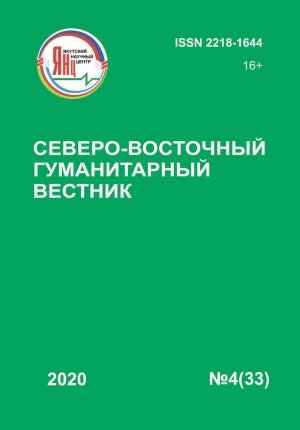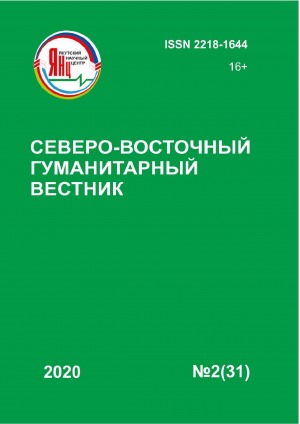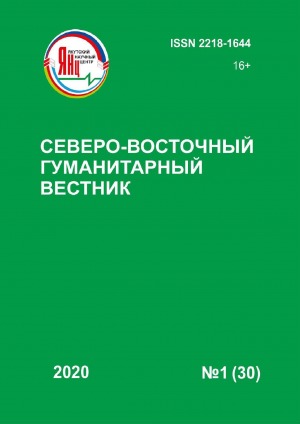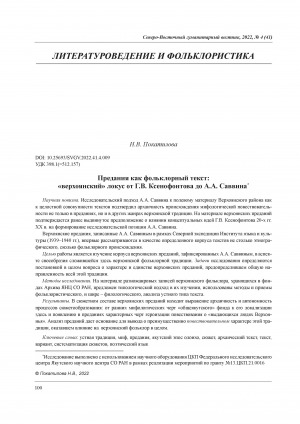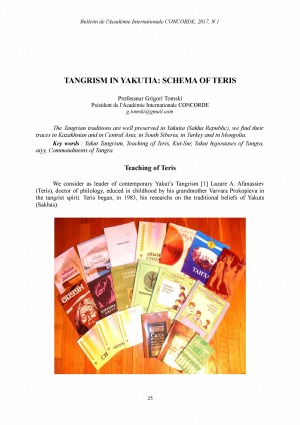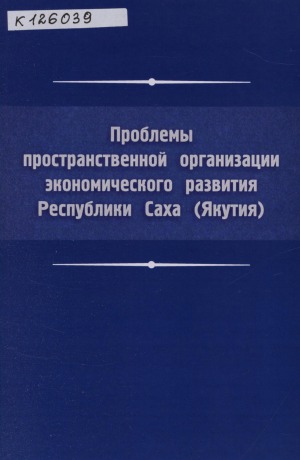Организован в 1949 г. как Якутский филиал АН СССР на основе Якутской научно-исследовательской базы АН СССР (Постановление СМ СССР от 7.9.1949). В 1957 г. включен в состав вновь созданного СО АН СССР и переименован в ЯФ СО АН СССР (Постановление СМ СССР от 18.5.1957). В 1988 ЯФ СО АН СССР преобразован в Якутский научный центр СО АН СССР (Постановление Президиума АН СССР от 25.10.1988), а в 1991 г. в связи с образованием РАН переименован в ЯНЦ СО РАН (Распоряжение Президиума РАН от 4.12.1991). Основные цели: организация и проведение фундаментальных научных исследований и прикладных работ, направленных на социально-экономическое развитие РС(Я). Как региональный научный центр СО РАН ЯНЦ объединяет 8 институтов: Институт биологических проблем криолитозоны, Институт геологии алмаза и благородных металлов, Институт мерзлотоведения им. П. И. Мельникова, Институт космофизических исследований и аэрономии им. Ю. Г. Шафера, Институт физико-технических проблем Севера им. В. П. Ларионова, Институт горного дела Севера им. Н. В. Черского, Институт проблем нефти и газа, Институт гуманитарных исслследований и проблем малочисленных народов Севера.
Ответственность: Ефремов Николай Николаевич (Редактор), Боякова Сардана Ильинична (Редактор), Гоголев Анатолий Игнатьевич (Редактор), Данилова Надежда Ивановна (Редактор), Васильева Надежда Матвеевна (Секретарь), Антонов Егор Петрович (Редактор), Бурцев Анатолий Алексеевич (Редактор), Бурыкин Алексей Алексеевич (Редактор), Винокурова Декабрина Михайловна (Редактор), Габышева Луиза Львовна (Редактор)
Издательство: ИГИиПМНС СО РАН
Год выпуска: 2021
Номер (№): 1 (34)
Количество страниц: 142 с.
- Периодические издания Якутии (конец XIX – XXI вв.) > Журналы > Северо-Восточный гуманитарный вестник > 2021,
- Рытхэу Юрий Сергеевич > О жизни и творчестве писателя,
- Общий отдел > Общие вопросы науки и культуры,
- НАУКА ЯКУТИИ > ОБЩИЙ ОТДЕЛ > Издания смешанного содержания. Сборники,
- КНИГАКАН > Все народы > Эвенки (тунгусо-маньчжурская группа языков) > Языкознание,
- КНИГАКАН > Все народы > Юкагиры (палеоазиатская группа языков) > Языкознание,
- КНИГАКАН > Все народы > Эвенки (тунгусо-маньчжурская группа языков) > Краеведение. География. История,
- КНИГАКАН > Все народы > Юкагиры (палеоазиатская группа языков) > Литературоведение.
Северо-Восточный гуманитарный вестник : научный журнал / учредитель Федеральный исследовательский центр "Якутский научный центр Сибирского отделения Российской академии наук" ; редколлегия: Ефремов Н. Н. (главный редактор.) [и др.]. — 2010 - . — Якутск : ФИЦ ЯНЦ СО РАН, 2010-. — Выходит 1 раз в квартал. — ISSN 2218-1644 (print). —
2021. — N 1 (34). — 132 с.
Ответственность: Ефремов Николай Николаевич (Редактор), Боякова Сардана Ильинична (Редактор), Гоголев Анатолий Игнатьевич (Редактор), Данилова Надежда Ивановна (Редактор), Васильева Надежда Матвеевна (Секретарь), Антонов Егор Петрович (Редактор), Бурцев Анатолий Алексеевич (Редактор), Бурыкин Алексей Алексеевич (Редактор), Винокурова Декабрина Михайловна (Редактор), Габышева Луиза Львовна (Редактор)
Издательство: ИГИиПМНС СО РАН
Год выпуска: 2020
Номер (№): 4 (33)
Количество страниц: 142 с.
- Периодические издания Якутии (конец XIX – XXI вв.) > Журналы > Северо-Восточный гуманитарный вестник > 2020,
- Общий отдел > Издания смешанного содержания. Сборники,
- НАУКА ЯКУТИИ > ОБЩИЙ ОТДЕЛ > Издания смешанного содержания. Сборники,
- КНИГАКАН > Все народы > Эвены (тунгусо-маньчжурская группа языков) > Этнография. Фольклор,
- КНИГАКАН > Все народы > Юкагиры (палеоазиатская группа языков) > Этнография. Фольклор.
Северо-Восточный гуманитарный вестник : научный журнал / учредитель Федеральный исследовательский центр "Якутский научный центр Сибирского отделения Российской академии наук" ; редколлегия: Ефремов Н. Н. (главный редактор.) [и др.]. — 2010 - . — Якутск : ФИЦ ЯНЦ СО РАН, 2010-. — Выходит 1 раз в квартал. — ISSN 2218-1644 (print)
2020. — N 4 (33). — 139 с.
Ответственность: Ефремов Николай Николаевич (Главный редактор), Боякова Сардана Ильинична (Редактор), Гоголев Анатолий Игнатьевич (Редактор), Данилова Надежда Ивановна (Редактор), Васильева Надежда Матвеевна (Секретарь), Антонов Егор Петрович (Редактор), Бурцев Анатолий Алексеевич (Редактор), Бурыкин Алексей Алексеевич (Редактор), Винокурова Декабрина Михайловна (Редактор), Габышева Луиза Львовна (Редактор), Дмитриева Евдокия Николаевна (Редактор), Игнатьева Ванда Борисовна (Редактор), Илларионов Василий Васильевич (Редактор), Ларионова Анна Семеновна (Редактор), Мельничук Ольга Алексеевна (Редактор), Петров Александр Александрович (Редактор), Покатилова Надежда Володаровна (Редактор), Попова Наталья Иннокентьевна (Редактор), Романова Екатерина Назаровна (Редактор), Романова Лидия Николаевна (Редактор), Сивцева Саассылана Иннокентьевна (Редактор), Сивцева-Максимова Прасковья Васильевна (Прочие), Стручкова Наталья Анатольевна (Редактор), Филиппов Гаврил Гаврильевич (Редактор), Хазанкович Юлия Геннадьевна (Редактор), Покатилова Надежда Володаровна (Ответственный за выпуск)
Издательство: ИГИиПМНС СО РАН
Год выпуска: 2020
Номер (№): 2 (31)
Количество страниц: 142 с.
- Периодические издания Якутии (конец XIX – XXI вв.) > Журналы > Северо-Восточный гуманитарный вестник > 2020,
- Общий отдел > Общие вопросы науки и культуры,
- НАУКА ЯКУТИИ > ОБЩИЙ ОТДЕЛ > Научные учреждения, съезды, конгрессы, конференции, симпозиумы,
- НАУКА ЯКУТИИ > ОБЩИЙ ОТДЕЛ > Издания смешанного содержания. Сборники,
- КНИГАКАН > Краеведение. Археология. География. Биографии. История,
- КНИГАКАН > Все народы > Эвены (тунгусо-маньчжурская группа языков) > Этнография. Фольклор.
Северо-Восточный гуманитарный вестник : научный журнал / учредитель Федеральный исследовательский центр "Якутский научный центр Сибирского отделения Российской академии наук" ; редколлегия: Ефремов Н. Н. (главный редактор.) [и др.]. — 2010 - . — Якутск : ФИЦ ЯНЦ СО РАН, 2010-. — Выходит 1 раз в квартал. — ISSN 2218-1644 (print). — 2020. — N 2 (31). — 138 с.
Ответственность: Ефремов Николай Николаевич (Главный редактор), Боякова Сардана Ильинична (Редактор), Гоголев Анатолий Игнатьевич (Редактор), Данилова Надежда Ивановна (Редактор), Васильева Надежда Матвеевна (Секретарь), Антонов Егор Петрович (Редактор), Бурцев Анатолий Алексеевич (Редактор), Бурыкин Алексей Алексеевич (Редактор), Винокурова Декабрина Михайловна (Редактор), Габышева Луиза Львовна (Редактор), Дмитриева Евдокия Николаевна (Редактор), Игнатьева Ванда Борисовна (Редактор), Илларионов Василий Васильевич (Редактор), Ларионова Анна Семеновна (Редактор), Мельничук Ольга Алексеевна (Редактор), Петров Александр Александрович (Редактор), Покатилова Надежда Володаровна (Редактор), Попова Наталья Иннокентьевна (Редактор), Романова Екатерина Назаровна (Редактор), Романова Лидия Николаевна (Редактор), Сивцева Саассылана Иннокентьевна (Редактор), Сивцева-Максимова Прасковья Васильевна (Прочие), Стручкова Наталья Анатольевна (Редактор), Филиппов Гаврил Гаврильевич (Редактор), Хазанкович Юлия Геннадьевна (Редактор), Покатилова Надежда Володаровна (Ответственный за выпуск)
Издательство: ИГИиПМНС СО РАН
Год выпуска: 2020
Номер (№): 1 (30)
Количество страниц: 136 с.
- Периодические издания Якутии (конец XIX – XXI вв.) > Журналы > Северо-Восточный гуманитарный вестник > 2020,
- Общий отдел > Общие вопросы науки и культуры,
- НАУКА ЯКУТИИ > ОБЩИЙ ОТДЕЛ > Общие вопросы науки и культуры,
- КНИГАКАН > Все народы > Юкагиры (палеоазиатская группа языков) > Этнография. Фольклор,
- КНИГАКАН > Все народы > Эвенки (тунгусо-маньчжурская группа языков) > Языкознание,
- КНИГАКАН > Все народы > Юкагиры (палеоазиатская группа языков) > Художественная литература,
- КНИГАКАН > Общий отдел.
Северо-Восточный гуманитарный вестник : научный журнал / учредитель Федеральный исследовательский центр "Якутский научный центр Сибирского отделения Российской академии наук" ; редколлегия: Ефремов Н. Н. (главный редактор.) [и др.]. — 2010 - . — Якутск : ФИЦ ЯНЦ СО РАН, 2010-. — Выходит 1 раз в квартал. — ISSN 2218-1644 (print)
2020. — N 1 (30). — 133 с.
Количество страниц: 12 с.
Scientific novelty. For the first time in a comparative aspect with the epic heritage of the Turkic-Mongolian peoples the internal media formulas of the miraculous rapid growth of the hero in the Yakut fairy tales and olonkho are considered. The aim of the study is to identify varieties of formulas for the miraculous growth of a hero in Yakut fairy tales and olonkho in comparison with the heroic epos and fairy tales of the Turkic-Mongolian peoples. In the process of research work were applied methods of systematization and comparative analysis. As a result of the study, the following typologically stable internal medial formulas are identified that describe the rapid growth of the hero in the epic and fairy tale: - indicating the time of growth of the hero: one day is equal to a year; one day is equal to month, a month is equal to a year; one hour is equal to a year; a hero grows by leaps and bounds; - describing the superhuman abilities of the hero: a hero does not fit into the skin of large animals; a hero knows how to talk immediately after birth (speaks to parents); a hero shows his strength and runs away from his parents; hyperbolic comparison formulas. Of these stable medial formulas of the hero’s miraculous growth, four were identified in the texts of the Yakut olonkho, and three in the Yakut fairy tale. For all types, the article provides not only examples from the texts of fairy tales and epics of the Turkic-Mongolian peoples in the original language with translation into Russian. The component composition of stable verbal expressions for the presence of artistic means is determined.
Павлова, Н. В. Особенности формул чудесного роста героя в якутской сказке и олонхо в сравнительном аспекте с тюрко-монгольским эпосом / Н. В. Павлова ; ФИЦ "Якутский научный центр СО РАН" // Северо-Восточный гуманитарный вестник. - 2022. - N 4 (41). - С. 110-121. - DOI: 10.25693/SVGV.2022.41.4.010
DOI: 10.25693/SVGV.2022.41.4.010
Количество страниц: 11 с.
Scientific novelty. The research approach of A.A. Savvin to the field material of the Verkhoyansk region as an integral set of texts confirmed the archaism of the origin of the mythological narrative not only in legends, but also in other genres of the Verkhoyansk tradition. On the material of the Verkhoyansk legends, the previously put forward assumption about the influence of the conceptual ideas of G.V. Xenofontov in the 1920s 20th century on the formation of the research position of A.A. Savvin. Verkhoyansk legends recorded by A.A. Savvin within the framework of the Northern Expedition of the Institute of Language and Culture (1939-1940), are considered for the first time as a certain body of texts not so much of ethnographic as of folklore origin. The aim of the work is to study the corpus of Verkhoyansk legends recorded by A.A. Savvin, in the aspect of the originality of the Verkhoyansk folklore tradition that has developed here. The tasks of the study are determined by the general formulation of the question of the nature and unity of the Verkhoyansk legends, which predetermined the general direction of this entire tradition. Research methods. On the material of records of different genres of Verkhoyansk folklore, stored in the archives of the YSC SB RAS, a typological approach to their study is proposed, methods and techniques of folklore, and more broadly - philological, analysis of the oral type of text are used. Results. In the plot structure of the Verkhoyansk legends, the archaic and autonomy of the processes of plot formation finds expression: from the early mythological features of the “general Yakut” fund to its localization here and the appearance in the legends of the characteristic features of the glorification of the story about the “outstanding people of Verkhoyansk”. An analysis of the legends gives grounds for concluding that this tradition was predominantly narrative in nature, which influenced the Verkhoyansk folklore as a whole.
Покатилова, Н. В. Предания как фольклорный текст: "верхоянский" локус от Г. В. Ксенофонтова до А. А. Саввина / Н. В. Покатилова ; ФИЦ "Якутский научный центр СО РАН" // Северо-Восточный гуманитарный вестник. - 2022. - N 4 (41). - С. 100-110. - DOI: 10.25693/SVGV.2022.41.4.009
DOI: 10.25693/SVGV.2022.41.4.009
Количество страниц: 12 с.
The scientific novelty of the study lies in the fact that pastoral vocabulary in the composition of phraseological units and proverbs as a basis for characterizing a person, as well as for expressing the moral postulates of the people, was not the object of study in comparison with the data of the Mongolian languages. The aim of the work is to identify and describe the metaphorical expression of the characteristics and evaluation of a person, his physical abilities and moral requirements for him in the Yakut phraseological and paremiological units with the components horse, cow, bull, foal in comparison with their equivalents in the Kalmyk and Buryat languages. The article uses methods and techniques of descriptive, semantic and comparative analysis, applied elements of the method of systematization of dictionary definitions. By the method of continuous sampling from lexicographic sources: explanatory, translated, phraseological dictionaries, phraseological and paremiological units were established that express the characteristics of a person and moral and ethical norms in relation to his actions. The classification of the studied units by semantic types is carried out. Results. The study made it possible to establish that cattle-breeding vocabulary as part of the phraseological and paremiological units of the compared languages expresses the physical and moral characteristics of a person. These units also fully convey the collective ideas of the Yakuts, Buryats and Kalmyks about the rules based on ideas about the attitude to work and the basic principles of life: wealth / poverty, luck / failure, age. At the same time, the figurative, evaluative characteristics of a person, expressed by the words horse, cow, bull, foal, in general have positive connotative features, which is explained by the important role of cattle breeding in the life of these peoples.
Данилова, Н. И. Зооморфная лексика в составе якутских фразеологизмов и паремий (в сопоставлении с монгольскими языками) / Н. И. Данилова, Ф. Н. Дьячковский ; ФИЦ "Якутский научный центр СО РАН" // Северо-Восточный гуманитарный вестник. - 2022. - N 4 (41). - С. 67-78. - DOI: 10.25693/SVGV.2022.41.4.006
DOI: 10.25693/SVGV.2022.41.4.006
Количество страниц: 13 с.
- Краеведение. Археология. География. Биографии. История > Историческая наука. Историография > История Якутии > Якутия до 1917 г.,
- Краеведение. Археология. География. Биографии. История > Историческая наука. Историография > История Якутии > Якутия с 1917 по 1940 гг.,
- Краеведение. Археология. География. Биографии. История > Историческая наука. Историография > История Якутии > Якутия в годы Великой Отечественной войны 1941-1945 гг.,
- НАУКА ЯКУТИИ > КРАЕВЕДЕНИЕ. ГЕОГРАФИЯ. БИОГРАФИИ. ИСТОРИЯ > Историческая наука. Историография > Всеобщая история > История Якутии.
Scientific novelty. The study of the formation process of monument protection activities is particular importance in the Cultural Heritage of the Peoples of Russia Year. The article attempts to identify the main stages in the development of monument protection activities in Yakutia, for the first time generalizes the experience of identifying and protecting historical and cultural monuments by public and research organizations, as well as government agencies operating on the territory of Yakutia in the 1920-1940s. Archival documents are introduced into scientific circulation, revealing the features of the organization of this activity in the period under review. Study of the issues of the historical and cultural monuments protection in Yakutia in the 1920-1940s carried out with the aim of reconstructing the main areas of work on this issue. Tasks: to recreate the idea of the formation and the first stages of the development of monument protection activities in Yakutia; to show the contribution of the first Yakut historians to the protection of historical and cultural monuments of Yakutia. Research methods: problem-chronological, historicism method, historical-biographical and historical-comparative. Results. The analysis of written and archival sources contributed to the reconstruction of the main stages in the formation of monument protection activities in the 1920-1940s on the territory of Yakutia. The great contribution of the Yakut researchers of this period to the protection of monuments and their accounting is noted - the surviving documents, reports, minutes of meetings can make a great contribution to the study of the history of the protection of historical and cultural heritage sites. The importance of conducting research and educational activities by the first Yakut scientists in the state protection of historical and cultural monuments is emphasized.
Апросимов, Д. А. Становление государственной системы охраны памятников истории и культуры Якутии (1920-е ‒июнь 1941 гг.) / Д. А. Апросимов ; ФИЦ "Якутский научный центр СО РАН" // Северо-Восточный гуманитарный вестник. - 2022. - N 4 (41). - С. 41-53. - DOI: 10.25693/SVGV.2022.41.4.004
DOI: 10.25693/SVGV.2022.41.4.004
Количество страниц: 12 с.
Scientific novelty. For the first time, based on unpublished archival ego-documents from the scientific heritage of G.V. Ksenofontov reveals the conflict between the intellectual and the official Soviet ideology in constructing a new language for describing reality within the framework of national discourse. The aim of the study focuses on the history of the formation of his cultural concept of the origin of Christianity as a world religion. In accordance with the aim, tasks were set to identify the circle of scientific opponents of G. V. Ksenofontov, systematization of the biographical facts of his cooperation with the “Union of militant atheists” on anti-religious propaganda, the study of the origin of religion and shamanism. Research methods. Based on the methodology of the “new biographical history” (social personal history), the model of the formation of the individual scientific strategy of G.V. Ksenofontov during the construction of the early Soviet society. Intellectual biography is reconstructed through the prism of socio-cultural analysis, which makes it possible to reveal the social context of space and time, the environment in which the scientific “picture of the world” of the scientist was formed. Results. Cross-cultural approach G.V. Ksenofontov to the study of historical processes was largely based on the works of the German ethno-geographical and cultural-historical school, the sociology of religion by E. Durheim and the methodology of historical materialism. A very important note in the researcher’s methodological discourse is an individual strategy for overcoming the conflict with the new government by using the basic provisions of Marxism-Leninism in his fundamental works. During the period of active atheistic propaganda (1927-1935), the scientist made presentations in the society “Godless” and the Research Buryat-Mongolian Society named after. D. Banzarova, publishes their works on the early religious beliefs of the peoples of Siberia. His ideas about the emergence of Christianity among the nomads of Eurasia, broad cultural comparisons of the figure of Christ with a shaman-prophet and symbolic interpretations gradually took shape in the original authorэs concept from the standpoint of cultural and historical conditioning. For the first time, pastoral tribes of Central Asia were nominated by G.V. Ksenofontov for the role of true bearers and keepers of Christian values. The scientist sets a new vector of research on nomadism: the steppe culture is the successor of an ancient civilization that once flourished in the countries of the Near East and Northern China with the Mongolian-Manchurian steppes. The theological concept of the scientist demonstrates a critical analysis of theological interpretations of religious texts. His extensive comparative studies in the field of Christianity explained theology not from idealistic positions, but relied on a new cultural and historical paradigm of humanitarian knowledge and personal experience in studying the early beliefs of the peoples of Siberia.
Романова, Е. Н. Теологическая концепция Г. В. Ксенофонтова: становление нового дискурса (1920‒1930) / Е. Н. Романова, Л. Б. Степанова ; ФИЦ "Якутский научный центр СО РАН" // Северо-Восточный гуманитарный вестник. - 2022. - N 4 (41). - С. 9-20. - DOI: 10.25693/SVGV.2022.41.4.001
DOI: 10.25693/SVGV.2022.41.4.001
Ответственность: Попов Анатолий Афанасьевич (Автор обозрения, рецензии), Тарасов Михаил Егорович (Автор обозрения, рецензии)
Издательство: Издательский дом СВФУ
Год выпуска: 2021
Количество страниц: 108 с.
- Экономика Севера > Региональная экономика,
- Общественные науки. Образование > Экономика. Экономические науки. Политическая экономия > Региональная (территориальная) экономика. Земельный (аграрный) вопрос. Жилищное хозяйство,
- НАУКА ЯКУТИИ > ОБЩЕСТВЕННЫЕ НАУКИ > Экономика. Экономические науки. Политическая экономия.
Проблемы пространственной организации экономического развития Республики Саха (Якутия) / Н. В. Бочкарев, Т. Н. Гаврильева, В. Р. Дарбасов [и др.] ; Министерство науки и высшего образования Российской Федерации, Федеральный исследовательский центр "Якутский научный центр Сибирского отделения Российской Академии наук" (ЯНЦ СО РАН). - Якутск : Издательский дом СВФУ, 2021. - 104 с.

